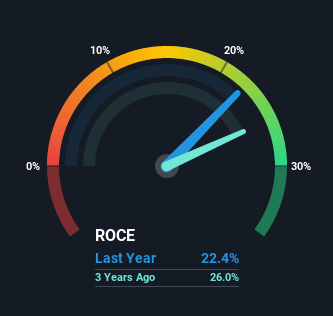- India
- /
- Trade Distributors
- /
- NSEI:SIGIND
Investors Could Be Concerned With Signet Industries' (NSE:SIGIND) Returns On Capital

Did you know there are some financial metrics that can provide clues of a potential multi-bagger? Ideally, a business will show two trends; firstly a growing return on capital employed (ROCE) and secondly, an increasing amount of capital employed. Ultimately, this demonstrates that it's a business that is reinvesting profits at increasing rates of return. Having said that, while the ROCE is currently high for Signet Industries (NSE:SIGIND), we aren't jumping out of our chairs because returns are decreasing.
What is Return On Capital Employed (ROCE)?
For those that aren't sure what ROCE is, it measures the amount of pre-tax profits a company can generate from the capital employed in its business. Analysts use this formula to calculate it for Signet Industries:
Return on Capital Employed = Earnings Before Interest and Tax (EBIT) ÷ (Total Assets - Current Liabilities)
0.22 = ₹523m ÷ (₹7.0b - ₹4.6b) (Based on the trailing twelve months to December 2020).
Therefore, Signet Industries has an ROCE of 22%. That's a fantastic return and not only that, it outpaces the average of 6.3% earned by companies in a similar industry.
Check out our latest analysis for Signet Industries

While the past is not representative of the future, it can be helpful to know how a company has performed historically, which is why we have this chart above. If you'd like to look at how Signet Industries has performed in the past in other metrics, you can view this free graph of past earnings, revenue and cash flow.
What The Trend Of ROCE Can Tell Us
On the surface, the trend of ROCE at Signet Industries doesn't inspire confidence. Historically returns on capital were even higher at 34%, but they have dropped over the last five years. Given the business is employing more capital while revenue has slipped, this is a bit concerning. This could mean that the business is losing its competitive advantage or market share, because while more money is being put into ventures, it's actually producing a lower return - "less bang for their buck" per se.
On a separate but related note, it's important to know that Signet Industries has a current liabilities to total assets ratio of 66%, which we'd consider pretty high. This effectively means that suppliers (or short-term creditors) are funding a large portion of the business, so just be aware that this can introduce some elements of risk. While it's not necessarily a bad thing, it can be beneficial if this ratio is lower.
Our Take On Signet Industries' ROCE
From the above analysis, we find it rather worrisome that returns on capital and sales for Signet Industries have fallen, meanwhile the business is employing more capital than it was five years ago. This could explain why the stock has sunk a total of 78% in the last five years. That being the case, unless the underlying trends revert to a more positive trajectory, we'd consider looking elsewhere.
If you want to know some of the risks facing Signet Industries we've found 5 warning signs (2 are a bit unpleasant!) that you should be aware of before investing here.
If you'd like to see other companies earning high returns, check out our free list of companies earning high returns with solid balance sheets here.
If you decide to trade Signet Industries, use the lowest-cost* platform that is rated #1 Overall by Barron’s, Interactive Brokers. Trade stocks, options, futures, forex, bonds and funds on 135 markets, all from a single integrated account. Promoted
New: Manage All Your Stock Portfolios in One Place
We've created the ultimate portfolio companion for stock investors, and it's free.
• Connect an unlimited number of Portfolios and see your total in one currency
• Be alerted to new Warning Signs or Risks via email or mobile
• Track the Fair Value of your stocks
This article by Simply Wall St is general in nature. It does not constitute a recommendation to buy or sell any stock, and does not take account of your objectives, or your financial situation. We aim to bring you long-term focused analysis driven by fundamental data. Note that our analysis may not factor in the latest price-sensitive company announcements or qualitative material. Simply Wall St has no position in any stocks mentioned.
*Interactive Brokers Rated Lowest Cost Broker by StockBrokers.com Annual Online Review 2020
Have feedback on this article? Concerned about the content? Get in touch with us directly. Alternatively, email editorial-team (at) simplywallst.com.
About NSEI:SIGIND
Signet Industries
Primarily engages in merchant trading of various polymer and plastic granules in India.
Good value second-rate dividend payer.

